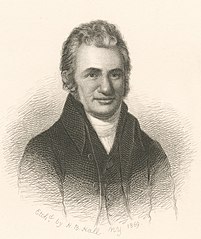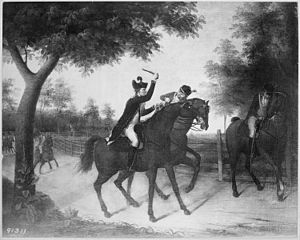| Allan McLane | |
|---|---|
 Engraved portrait of Allan McLane | |
| Born |
August 8, 1746 Philadelphia |
| Died | May 22, 1829 (aged 82) |
| Occupation |
|
| Military career | |
| Allegiance | United States of America |
| Service/branch | Continental Army |
| Years of service | 1775–1781 |
| Rank | |
| Battles/wars |
American Revolutionary War |
Allan McLane (August 8, 1746 – May 22, 1829) was an officer in the Continental Army during the American Revolutionary War. He was appointed as the first United States Marshal of Delaware in 1789, and as Customs Collector of the Port of Wilmington in 1797.[1]
Early life[]
Allan McLane was born on August 8, 1746 in Philadelphia,[2] where his Scottish-born father was a merchant.[3]
At age 21, McLane moved to central Delaware.
American Revolution[]

James Peale's painting of encounter between Allan McLane and British dragoons
McLane served in the Continental Army during the Revolutionary War. In 1775, he was a volunteer in the Battle of Great Bridge near Norfolk, Virginia, where the Virginia militia repelled a British assault.[4] He was one of the first American officers to suspect Benedict Arnold's loyalty.[2] He joined Caesar Rodney's Delaware regiment as a lieutenant, and fought at the battles of Long Island, White Plains, Princeton, and Monmouth.[4]
He used most of the fortune he inherited after his father died to fund his own company, providing payment and equipment for the troops.[3] During the Philadelphia campaign, according to historian Christopher Ward:
He was Captain of an independent corps, now a small group of horsemen, now a hundred men, mounted and on foot, including sometimes a contingent of Oneida Indians, he was at once forager, scout, and raider everywhere about Philadelphia and even, at times, in that city in disguise.[5]
In December 1777, in personal combat with three British dragoons near Philadelphia, Captain McLane killed one, wounded another, and compelled the third to flee.[6] The encounter became the subject of a painting by James Peale.[6]
During the Continental Army's encampment at Valley Forge in 1778, McLane led foraging parties.[3] He and his men cut off British expeditions and took their cattle. In July 1779, McLane and his company were annexed to Lee's Legion, with McLane to command the infantry.[7] McLane served under the command of Major "Light-Horse Harry" Lee at the Battles of Stony Point and Paulus Hook, but tensions between McLane and Lee ultimately caused Washington to send McLane and his company to Charleston, South Carolina to reinforce General Benjamin Lincoln.[3]
After the British captured Charleston in March 1780, McLane came under the command of Baron von Steuben, who was then assisting General Nathanael Greene in the Southern campaign.[3] He returned north, and was breveted to the rank of major in 1781.[3][6]

Painting of American privateer Congress capturing HMS Savage
In June 1781, McLane took ship on the American privateer Congress to carry dispatches from George Washington to Count Paul de Grasse, who was at Cap-François, Haiti, commanding a French fleet.[7] After convincing de Grasse to bring his fleet to Chesapeake Bay, McLane returned to New Jersey in September 1781.[7][8][9] Along the way, he commanded the Congress's Marines during the capture of HMS Savage, a British sloop-of-war.[7][8][9]
McLane continued to serve through the Yorktown campaign, scouting the movement of British troops southward from New York City,[3] and capturing British private naval signals.[7] He left the army at the end of 1781.[3]
Post-war career[]
McLane was a delegate at Delaware's convention to ratify the United States Constitution in December 1787.[10] He also served a member of the Privy Council, and as a Judge of the Delaware Court of Common Pleas.
He was appointed by George Washington as the first United States Marshal of Delaware on September 26, 1789,[1] and served until his resignation in 1797.[11] During this period, from October 1791 to January 1793, he also served as Speaker of the 16th Delaware General Assembly.
In 1797, Washington appointed McLane as Collector of Customs for the Port of Wilmington, a lucrative position that provided income from the seizure of contraband. As a well-known and a fervently loyal Federalist, McLane received the strong backing of James A. Bayard, who enabled him to keep the position despite the accession of Thomas Jefferson to the presidency in 1801.
McLane retained his appointment under presidents of both political parties, into the administration of Andrew Jackson, and served until his death on May 22, 1829, at the age of 83.[1]
Personal life and family[]

McLane's son Louis as Secretary of the Treasury
McLane lived in Smyrna, Delaware after the Revolutionary War. He moved with his family to Wilmington after his appointment as Collector of Customs there in 1797.[2]
He was a member of the Society of the Cincinnati, and a long-time advocate of the Methodist Church.[2]
His son, Louis McLane, served as the Secretary of the Treasury and Secretary of State under President Andrew Jackson.
References[]
- ↑ 1.0 1.1 1.2 "The First Marshal of Delaware: Allan McLane". U.S. Department of Justice. http://www.usmarshals.gov/history/firstmarshals/mclane.htm.
- ↑ 2.0 2.1 2.2 2.3 "Kent County Markers – Home of Allan McLane (Smyrna, Delaware)". http://archives.delaware.gov/markers/kc/KC-60A.shtml. Retrieved 2016-05-18.
- ↑ 3.0 3.1 3.2 3.3 3.4 3.5 3.6 3.7 "Allan McLane". Independence Hall Association. Archived from the original on 2017-11-02. https://web.archive.org/web/20171102043352/http://www.ushistory.org/valleyforge/served/mclane.html.
- ↑ 4.0 4.1 Denslow, William R. (1957). 10,000 Famous Freemasons. Vol. III (K–P). Richmond, Virginia: Macoy Publishing & Masonic Supply Co., Inc.. Archived from the original on 2017-10-22. https://web.archive.org/web/20171022193330/http://www.phoenixmasonry.org/10,000_famous_freemasons/Volume_3_K_to_P.htm.
- ↑ Ward, Christopher (1952). The War of the Revolution. II. New York: MacMillan. p. 547.
- ↑ 6.0 6.1 6.2 Burdick, Kim (October 15, 2014). "Allen McLane: Case Study in History and Folklore". Archived from the original on 2017-07-01. https://web.archive.org/web/20170701224835/https://allthingsliberty.com/2014/10/allen-mclane-case-study-in-history-and-folklore/.
- ↑ 7.0 7.1 7.2 7.3 7.4 Garden, Alexander (1828). "Allen M'Lean, of Delaware". In Miller, A.E.. Anecdotes of the American Revolution: Illustrative of the Talents and Virtues of the Heroes of the Revolution, Who Acted the Most Conspicuous Parts Therein – Second Series. Charleston, South Carolina. https://archive.org/details/AllanMcLane.
- ↑ 8.0 8.1 Ketchum, Richard M. (2014). Victory at Yorktown: The Campaign That Won the Revolution. Henry Holt and Company. pp. 171–172. ISBN 978-1-4668-7953-9. https://books.google.com/books?id=CwEDBAAAQBAJ&pg=PT171.
- ↑ 9.0 9.1 Cook, Fred J. (October 1956). "Allan McLane: Unknown Hero of the Revolution". Archived from the original on 2017-04-22. https://web.archive.org/web/20170422073108/http://www.americanheritage.com/content/allan-mclane-unknown-hero-revolution.
- ↑ Barratt, Norris S. (1911). Papers of the Historical Society of Delaware. LVII. Wilmington: The Historical Society of Delaware. p. 334. https://books.google.com/books?id=yewtAAAAYAAJ&pg=PA334.
- ↑ "U.S. Marshals 1789–1989: Delaware". U.S. Department of Justice. p. 2. https://www.usmarshals.gov/readingroom/us_marshals/delaware.pdf.
The original article can be found at Allan McLane and the edit history here.